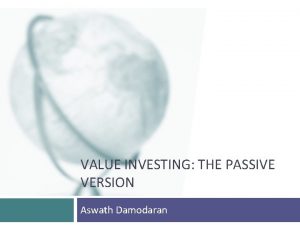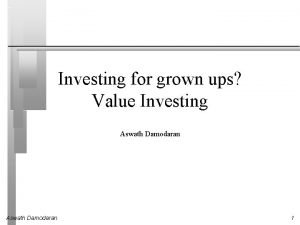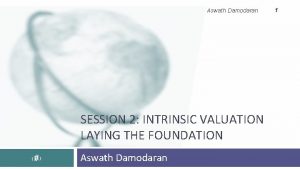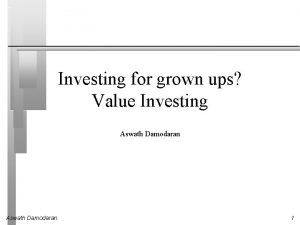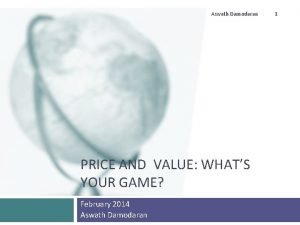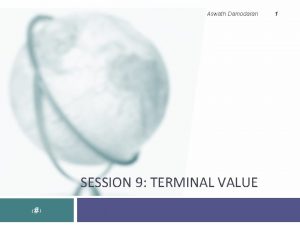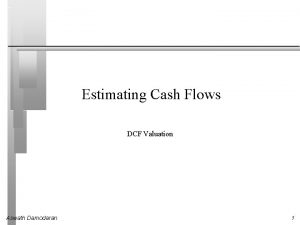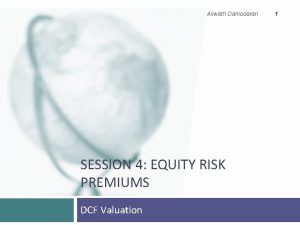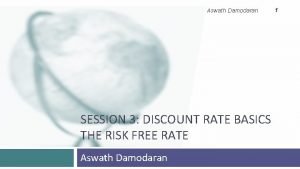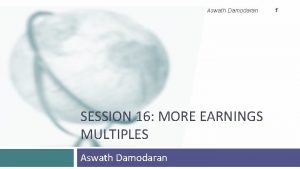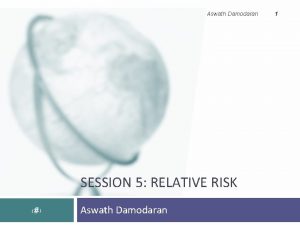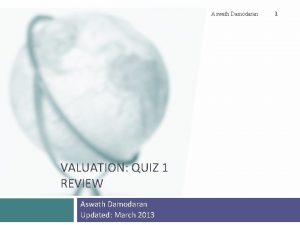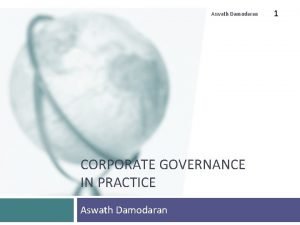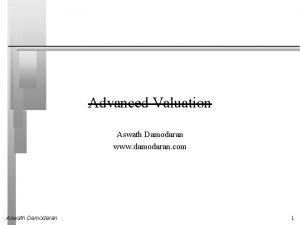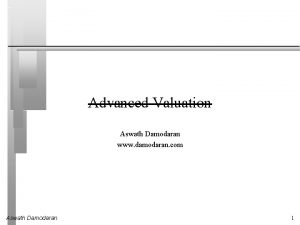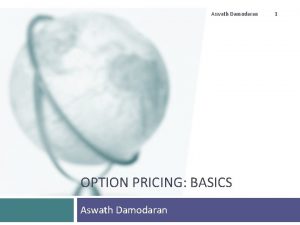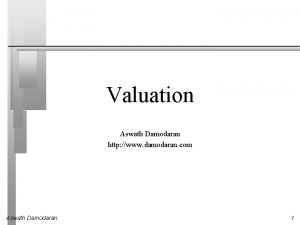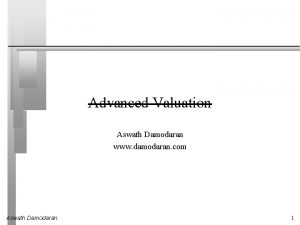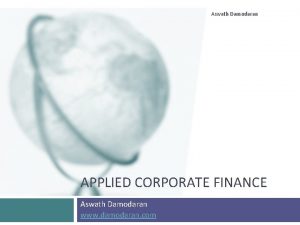Aswath Damodaran SESSION 9 TERMINAL VALUE 1 The












- Slides: 12

Aswath Damodaran SESSION 9: TERMINAL VALUE ‹#› 1

The Tail that wags the dog. 2 Aswath Damodaran 2

Getting Closure in Valuation A publicly traded firm potentially has an infinite life. The value is therefore the present value of cash flows forever. Since we cannot estimate cash flows forever, we estimate cash flows for a “growth period” and then estimate a terminal value, to capture the value at the end of the period: 3 Aswath Damodaran 3

Ways of Estimating Terminal Value 4 Aswath Damodaran 4

Stable Growth and Terminal Value When a firm’s cash flows grow at a “constant” rate forever, the present value of those cash flows can be written as: Value = Expected Cash Flow Next Period / (r - g) where, r = Discount rate (Cost of Equity or Cost of Capital) g = Expected growth rate This “constant” growth rate is called a stable growth rate and cannot be higher than the growth rate of the economy in which the firm operates. While companies can maintain high growth rates for extended periods, they will approach “stable growth” at some point in time. 5

1. Obey the growth cap When a firm’s cash flows grow at a “constant” rate forever, the present value of those cash flows can be written as: Value = Expected Cash Flow Next Period / (r - g) where, r = Discount rate (Cost of Equity or Cost of Capital) g = Expected growth rate The stable growth rate cannot exceed the growth rate of the economy but it can be set lower. � If you assume that the economy is composed of high growth and stable growth firms, the growth rate of the latter will probably be lower than the growth rate of the economy. � The stable growth rate can be negative. The terminal value will be lower and you are assuming that your firm will disappear over time. � If you use nominal cashflows and discount rates, the growth rate should be nominal in the currency in which the valuation is denominated. One simple proxy for the nominal growth rate of the economy is the riskfree rate. 6 Aswath Damodaran 6

Risk free Rates and Nominal GDP Growth Risk free Rate = Expected Inflation + Expected Real Interest Rate The real interest rate is what borrowers agree to return to lenders in real goods/services. Nominal GDP Growth = Expected Inflation + Expected Real Growth The real growth rate in the economy measures the expected growth in the production of goods and services. The argument for Risk free rate = Nominal GDP growth 1. In the long term, the real growth rate cannot be lower than the real interest rate, since you have the growth in goods/services has to be enough to cover the promised rate. 2. In the long term, the real growth rate can be higher than the real interest rate, to compensate risk taking. However, as economies mature, the difference should get smaller and since there will be growth companies in the economy, it is prudent to assume that the extra growth comes from these companies. 10 -Year T. Bond Nominal GDP - T. Bond Period 1954 -2015 1954 -1980 1981 -2008 2009 -2015 Rate 5. 93% 5. 83% 6. 88% 2. 57% Inflation Rate Real GDP Growth 3. 61% 3. 06% 4. 49% 3. 50% 3. 26% 3. 04% 1. 66% 1. 47% growth rate 6. 67% 7. 98% 6. 30% 3. 14% Rate 0. 74% 2. 15% -0. 58% 0. 57%

A Practical Reason for using the Risk free Rate Cap – Preserve Consistency You are implicitly making assumptions about nominal growth in the economy, with your risk free rate. Thus, with a low risk free rate, you are assuming low nominal growth in the economy (with low inflation and low real growth) and with a high risk free rate, a high nominal growth rate in the economy. If you make an explicit assumption about nominal growth in cash flows that is at odds with your implicit growth assumption in the denominator, you are being inconsistent and bias your valuations: � � If you assume high nominal growth in the economy, with a low risk free rate, you will over value businesses. If you assume low nominal growth rate in the economy, with a high risk free rate, you will under value businesses. 8 Aswath Damodaran 8

2. Don’t wait too long… Assume that you are valuing a young, high growth firm with great potential, just after its initial public offering. How long would you set your high growth period? a. b. c. d. < 5 years 10 years >10 years While analysts routinely assume very long high growth periods (with substantial excess returns during the periods), the evidence suggests that they are much too optimistic. Most growth firms have difficulty sustaining their growth for long periods, especially while earning excess returns. 9 Aswath Damodaran 9

3. Don’t forget that growth has to be earned. . 10 Aswath Damodaran 10

The Big Assumption Growth rate forever Return on capital in perpetuity 6% 8% 10% 12% 14% 0. 0% $1, 000 $1, 000 0. 5% $965 $987 $1, 000 $1, 009 $1, 015 1. 0% $926 $972 $1, 000 $1, 019 $1, 032 1. 5% $882 $956 $1, 000 $1, 029 $1, 050 2. 0% $833 $938 $1, 000 $1, 042 $1, 071 2. 5% $778 $917 $1, 000 $1, 056 $1, 095 3. 0% $714 $893 $1, 000 $1, 071 $1, 122 Terminal value for a firm with expected after-tax operating income of $100 million in year n+1 and a cost of capital of 10%. 11 Aswath Damodaran 11

4. Be internally consistent Risk and costs of equity and capital: Stable growth firms tend to � � � Have betas closer to one Have debt ratios closer to industry averages (or mature company averages) Country risk premiums (especially in emerging markets should evolve over time) The excess returns at stable growth firms should approach (or become) zero. ROC -> Cost of capital and ROE -> Cost of equity The reinvestment needs and dividend payout ratios should reflect the lower growth and excess returns: � � Stable period payout ratio = 1 - g/ ROE Stable period reinvestment rate = g/ ROC 12 Aswath Damodaran 12
 Aswath damodaran value investing
Aswath damodaran value investing Value investing damodaran
Value investing damodaran Damodaran
Damodaran Aswath damodaran intrinsic value
Aswath damodaran intrinsic value Aswath damodaran value investing
Aswath damodaran value investing Aswath damodaran intrinsic value
Aswath damodaran intrinsic value Terminal value damodaran
Terminal value damodaran Damodaran dcf
Damodaran dcf Damodaran statistics
Damodaran statistics Damodaran dcf
Damodaran dcf Damodaran discount rates
Damodaran discount rates Aswath damodaran ebitda
Aswath damodaran ebitda Damodaran discount rates
Damodaran discount rates
